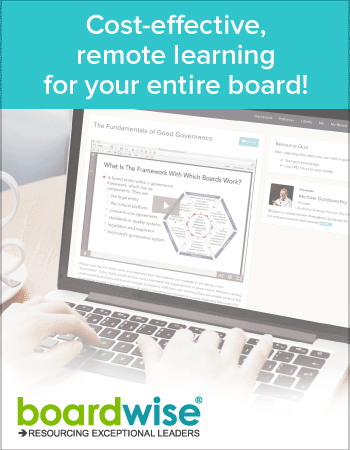performance-metrics
5 Cognitive Biases That Quietly Influence Boardroom Decisions
Published: May 25, 2025
Read Time: 7 minutes

As human beings, we naturally want to think of ourselves as valuable and special, making us more adaptable while at the same time creating cognitive biases in our brains. Cognitive biases are repeated errors in thinking, often coming from stereotypes or preconceived notions. These biases are hard to detect and can lead to bad choices and illogical decisions. The first steps to overcoming or disrupting cognitive biases are to recognise that they exist and to replace faulty thinking with better information.
In the boardroom, inaccurate thinking can lead to negative consequences in the long term. When ignored in favour of the status quo, biases can affect the board’s ability to provide good governance and do its due diligence. It can make board members reluctant to ask questions and afraid to challenge long-time directors, say Adrianne Trainor and Byron Loflin from the Center for Board Excellence. Asking questions and voicing dissent are not only constructive for board governance but essential to having meaningful dialogue, helping speak truth to power and navigating crises.
Types of Cognitive Biases
There are two categories of cognitive biases: information bias and ego bias. Information biases are caused by errors in information processing that lead to inaccurate decisions or missed details. Ego biases are founded on emotional and social factors such as motivation, anger, fear, peer pressure, anxiety, and the need for acceptance, which can lead to believing we (or others) are correct. Whether a cognitive bias is ego-based or information-based, it usually results in poor interpretation of information, which leads to inaccurate judgments or bad choices.
Here are five examples of cognitive biases that can affect your leadership:
Status Quo Bias
A fear of change can create the conditions for status quo bias, a tendency to prefer established norms and values and stick to what is familiar. When the market is disrupted, shifting the business model becomes critical. Boards with status quo bias can struggle with identifying the causes and effects of these disruptions, choosing instead to continue with their traditional approach to solving a problem.
Directors who have been serving for a long time can miss clues about why an organisation is performing poorly, rather than conducting a thorough assessment of their capacity to respond to external factors. To avoid status quo bias, boards must continuously refresh their skills and knowledge. Strategies like revising the organisation structure, re-considering the roles and responsibilities of the team, and holding strategic development sessions are vital for renewing priorities and identifying new needs.
Authority Bias
Board members are selected for their expertise and skills, often making them a key person people go to for advice when problems arise. Some directors are sometimes relied on too much for their opinions, overshadowing the voices of others. The recent acceleration of artificial intelligence (AI) is a great example of a challenge that requires new ideas and approaches. Many of Australia’s executives know they need to adapt and integrate AI, but have no clear strategy or lack the capacity to do it. Addressing AI safety concerns, content ownership, and investment needs requires new ideas and a new vision to keep organisations competitive.
New directors are often undervalued but may have fresh ideas. To reduce status quo bias, directors must have the awareness to step back during discussions. Using techniques like check-ins that provide opportunities to voice concerns and ask questions, go-rounds that give each person a turn to speak, and progressive facilitation where a chair steps back and encourages participants to contribute to the conversation are key to giving all directors the space to participate. Alternatively, setting time limits for speaking and giving newer members opportunities to lead discussions can reduce the tendency to defer to a perceived authority figure in the room.
Group Think
Dr. Colin Fisher describes group think as making decisions without considering alternative information or fielding criticism. He uses the example of Coca-Cola’s decision to launch a reformulated version of its classic drink in 1985, a move that was overwhelmingly rejected by consumers. Group think is often a consequence of wanting to be accepted by others by finding common ground or agreeing with their ideas.
When group think becomes firmly established, discussions become biased and valid concerns or differences of opinion risk being ignored. Fisher adds that disagreements are healthy, and group think risks making directors hold back during board meetings. Boards that provide several options and ensure background information is available during decision-making can avoid this bias. Choosing directors with conflict resolution and critical thinking skills can reduce group think and give group members the confidence to challenge ideas and name blind spots.
Confirmation Bias
Confirmation bias is “the tendency to gather evidence that confirms preexisting expectations, typically by emphasising or pursuing supporting evidence while dismissing or failing to seek contradictory evidence”, according to the APA. The risk of confirmation bias is that people’s own beliefs are always validated, and projects, discussions, and reports can be based on inaccurate information.
When boards don’t have access to all of the information they need to make a decision, they are more likely to have poor outcomes. To avoid confirmation bias, boards must proactively seek out missing details and ask questions about the information they receive. Inviting experts to speak on certain issues or topics can help the group see the big picture. In addition, exploring cognitive biases during the board assessment process can provide important insights and help start difficult but necessary conversations.
Unconscious Bias
In the boardroom, making assumptions can create unfair advantages or disadvantages and influence the thinking and actions of the board. This can influence director’s choices or lead to flawed decision making. Monash University defines unconscious bias as the “attitudes and patterns of perceptions that are held subconsciously”. Through the unconscious mind, preconceived ideas about gender or race can create challenges in the workplace and make it difficult for some directors to be heard.
Overcoming unconscious bias requires engaging with different perspectives, inviting people from diverse backgrounds to sit at the table, and thinking about board diversity. Diversifying a board can result in better governance and enhance an organisation’s reputation, broadening relationships with the public. Diverse boards have less group think and have a better understanding of the needs of their stakeholders.
How to Overcome Cognitive Bias
According to Dr. Jim Taylor, executives can overcome cognitive biases by raising their awareness. Self-assessing and asking for regular feedback can help directors recognise potential cognitive biases. Taylor suggests introducing a collaborative approach to providing oversight that involves group brainstorming and discussions. Closer collaboration can help raise awareness of issues that are obvious to some in the group and not to others.
In addition, boards can offer multiple options when making decisions. Most cognitive biases arise when leaders assume they already know the answers and how to respond to a problem. These biases become more evident when the board conducts a thorough exploration of the facts, such as reviewing reports and executive summaries and becoming familiar with alternative approaches.
Sherrin Ingram from the National Association of Corporate Directors in Arlington, Virginia (USA), emphasised the value of professional development and lifelong learning. Ingram says that creating opportunities for directors to get a fresh perspective can help identify cognitive biases. Introducing tools such as real-time surveys and polls can raise awareness, and a permanent agenda item about potential biases can help manage the risks. Ingram recommends appointing one director to act as the ‘contrarian’, challenging the status quo by asking questions during board meetings.
–
Additional Resources
Board Dynamics: Overcoming Miscommunication Among Directors
Director Selection: Finding the Right Fit
Gavin Nicholson on Handling Complexity in Board Decision Making
Further Reading
Six cognitive biases that affect your leadership
Calling Out Gender Bias in the Boardroom
Opinion: Group-think aka the group-thinking trap: what it means and how to avoid it
How racial bias works – and how to disrupt it
Cognitive Biases 101, with Peter Baumann | Big Think
Share this Article
Recommended Reading
Recommended Viewing
Author
- About
-
Better Boards connects the leaders of Australasian non-profit organisations to the knowledge and networks necessary to grow and develop their leadership skills and build a strong governance framework for their organisation.
Found this article useful or informative?
Join 5,000+ not-for-profit & for-purpose directors receiving the latest insights on governance and leadership.
Receive a free e-book on improving your board decisions when you subscribe.
Unsubscribe anytime. We care about your privacy - read our Privacy Policy .









